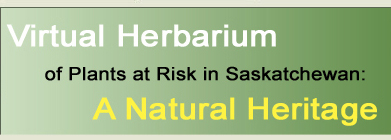
|

|

|

|

|

|

|
|
|
|
|
|
| Lactuca ludoviciana (Nutt.) Riddell | Species Image Gallery (opens in a new window) |
||||||||||||||||||||||||||||||||
| TAXONOMY | |||||||||||||||||||||||||||||||||
| Family: | Asteraceae or Compositae | ||||||||||||||||||||||||||||||||
| Genus: | Lactuca | ||||||||||||||||||||||||||||||||
| Species Synonyms: | Lactuca campestris Greene Lactuca campestris var. typica Wieg. |
||||||||||||||||||||||||||||||||
| Common Names: | wild lettuce biannual lettuce western wild lettuce |
||||||||||||||||||||||||||||||||
| DISTRIBUTION | |||||||||||||||||||||||||||||||||
| Canada: | southeastern Saskatchewan – southern Manitoba | ||||||||||||||||||||||||||||||||
| Saskatchewan: | southeastern Saskatchewan; Antler River Valley | ||||||||||||||||||||||||||||||||
| Ecoregion: | Aspen Parkland | ||||||||||||||||||||||||||||||||
| HABITAT | |||||||||||||||||||||||||||||||||
| Saskatchewan: | low shrublands in river valleys | ||||||||||||||||||||||||||||||||
| RARITY STATUS | |||||||||||||||||||||||||||||||||
| Provincial
Status According to Harms (2003): |
Endangered |
||||||||||||||||||||||||||||||||
| Nature Conservancy Status: | G4G5 S1 |
||||||||||||||||||||||||||||||||
| Saskatchewan
Species at Risk Status: |
None |
||||||||||||||||||||||||||||||||
| COSEWIC Status: | None |
||||||||||||||||||||||||||||||||
| Tall blue lettuce is apparently secure, with numerous populations throughout the province. However, local populations are small, leaving this plant vulnerable to changes in habitat. | |||||||||||||||||||||||||||||||||
| SPECIES DESCRIPTION | |||||||||||||||||||||||||||||||||
| Height: | 1 – 2 m tall | ||||||||||||||||||||||||||||||||
| Roots: | taproot | ||||||||||||||||||||||||||||||||
| Stems: | to 1 cm wide, solid, hairless, latex brown | ||||||||||||||||||||||||||||||||
| Leaves: | basal and lower leaves sessile, 20 – 30 cm long, 5 – 10 cm wide, oval to spoon-shaped, base arrow-like to clasping, hairless, upper midvein short hairy, variously toothed or deeply lobed; middle and upper leaves alternate, clasping with ear-like lobes, 5 – 15 cm long, 3 – 5 cm wide, reduced slightly upwards, oval to spoon-shaped, toothed to lobed, margins sharp but not prickly | ||||||||||||||||||||||||||||||||
| Inflorescence: | heads 50 – 100 in loose, branched clusters, to 1 cm across, ray flowers only; bracts ~17, 15 – 23 mm high, overlapping, not black-tipped | ||||||||||||||||||||||||||||||||
| Flowers: | ray flowers 20 – 30; 5 – 5.5 mm long, blue, blue with yellow at apex or yellow; anthers white | ||||||||||||||||||||||||||||||||
| Fruits: | achenes 4 – 5 mm long, 2 – 3 mm wide, flattened, conspicuous ridge on both sides, dark brown; beak 3 – 4 mm long, thread-like; pappus in 3 – 4 series, white | ||||||||||||||||||||||||||||||||
| |||||||||||||||||||||||||||||||||